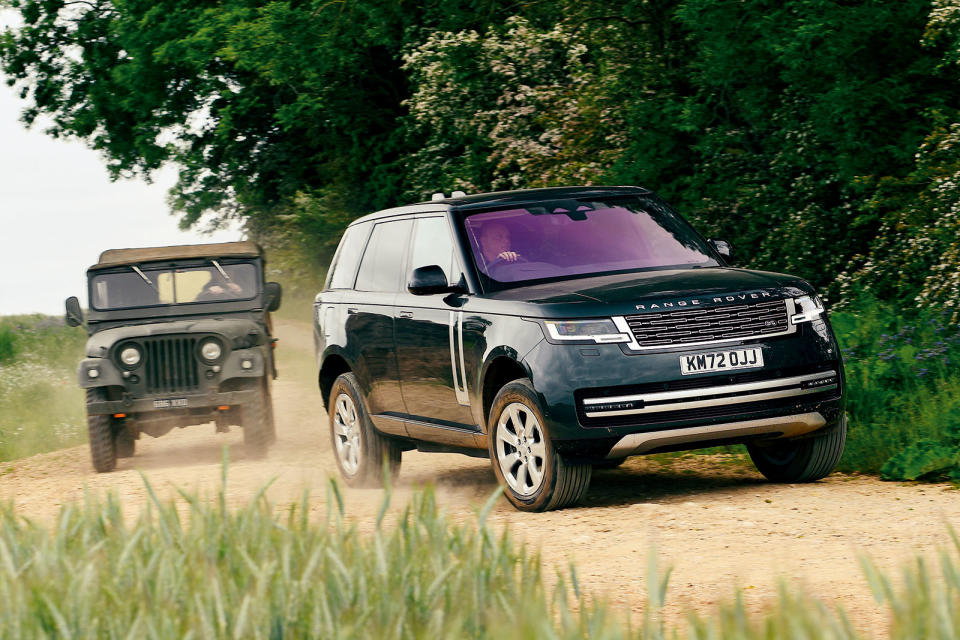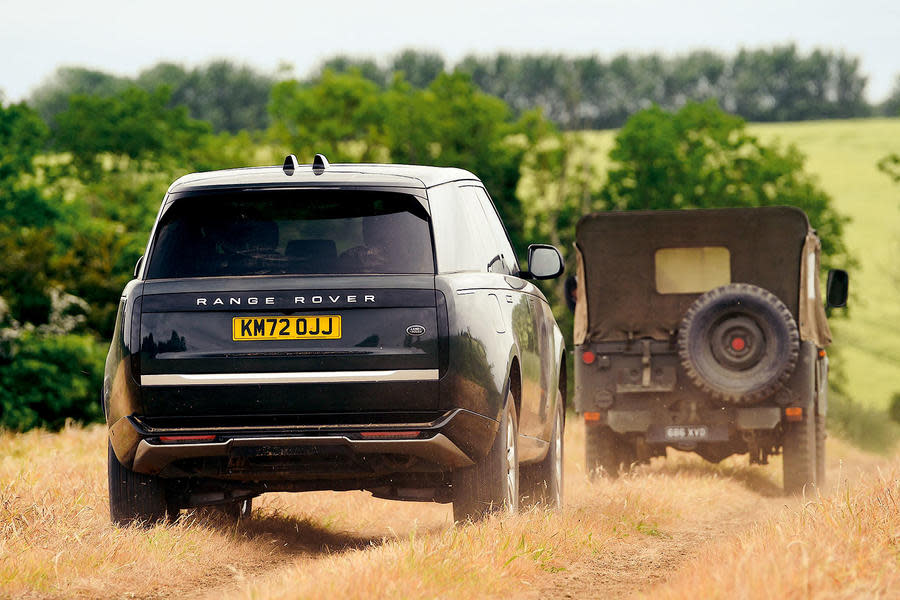Willys Jeep vs Range Rover: how has off-road capability changed?

Both of these are unstoppable, but only one gives its driver a full body workout
Ever since God was a child, people have been trying to solve the conundrum of how to get places.
First it was just with our legs. Then we discovered horses and worked out that their limbs were better than ours.
Then, skipping forward a tad, the industrial revolution dropped and the options multiplied tenfold: cars, bikes, trains, planes, scooters, hoverboards and on and on, ad infinitum.
But the fundamentals of getting somewhere tricky have remained remarkably constant in our Autocar world – four bits of rubber shrouding four round bits of metal. And yet, as you can see from the images here, there’s a vast difference across the decades as to how that conundrum is solved.

To the new car, then. It’s the Range Rover plug-in hybrid, and while it’s not ideally suited to out-and-out off-road adventuring (more on that shortly), it is absolutely laden with the latest electronic off-road tech.
You could argue that we should have had the Land Rover Defender on this test, it being the halo off-roader and the ultimate expression of where the capability has got to, but to be honest I’m more interested in where the technology has enabled luxury and mud to mix.
Quick links: Willys Jeep - Range Rover - Off-road performance: Range Rover - Off-road performance: Willys Jeep - The downsides - Verdict - Full specs
Introducing the Willys Jeep
How far can this tech be pushed? Certainly a chunk further than with the other car here. It’s a Willys Jeep, of the M38A1 variety.
Technically it’s not the oldest of the breed, as this particular one was built in 1955 under licence in the Netherlands (a Nekaf Dutch variant, to be precise), but if Spyker can claim to be the first with a four-wheel-drive passenger vehicle, it’s generally accepted that Willys and the original WW2 Jeep made the genre what it is today. And this car is a successor to that icon of the Second World War.

It’s basic in the extreme: leaf spring suspension all round, a choice of four- and two-wheel drive that is switchable by a very long lever, and a high- and low-range gearbox, all powered by a water-cooled, four-cylinder Hurricane engine linked to a three-speed ’box.
There are no doors or heater, and technology is limited to a set of dials, most of which don’t seem to work. If an item isn’t needed in order to fulfil the car’s singular, go-anywhere purpose, it’s not on it.
Introducing the Range Rover
The contrast to the Range Rover is extreme. Here is the car that should be able to drive both to and up the ski slope, with barely a fluster.
Air suspension that can raise the body by 135mm and Land Rover’s first-ever five-link rear axle take care of the comfort, while the six-setting Terrain Response 2, e-locking rear and centre diffs, rear-axle steering with 7.3deg of possible turn and low-speed gearbox mean the off-road box is also ticked.

The reason it’s not the ideal Range Rover is because of the PHEV element. While that is enabling us to achieve fuel economy in the mid- to high 30s, the 38.2kWh battery sits low under the chassis, thereby reducing the ramp angle by 2.5deg and the ground clearance by 11mm from a regular Range Rover.
The aim of the day, then, is a simple one. To discover if luxury has blunted ability.
Off-road performance: Range Rover
We start off with a seriously steep drop down into a quarry, where the challenge is not only the angle but also the surface, being a vicious mix of smooth stone and more grippy shale rock.
The four cameras on the Rangie immediately come in handy – although Gerry McGovern’s styling looks good on the King’s Road, it tapers away from the visible edges so the car is difficult to place.

Switch it to off-road mode (max height on the air suspension) and use the ClearSight Ground View mode (essentially a function that allows you to peer through the bonnet) and suddenly it’s clear what’s ahead.
Select hill descent and low range, wind the maximum speed right back within the settings and let the car simply creep down the slope. This isn’t new or unique to Range Rover, but every time it never fails to amaze how damn easy it has all become. Even the change in surface halfway down doesn’t upset it.
Off-road performance: Willys Jeep
The Jeep is just as capable, but not as relaxing. It’s in low range as I head over the edge, but then bounces and careers down the hill with the sort of suspension movement that wouldn’t look out of place in a Benny Hill movie.
You don’t worry about it like you do with the Range Rover (the £130k price difference will do that to you), but there’s never quite the level of faith that tyres/brakes/clutch will do what you need when you need (the car’s 68-year-old age will do that to you).
Where the Jeep does feel happier is on a cross slope. It’s narrow at just 152cm wide but stable, and because it’s so light, it doesn’t pull itself down the slope.

The Range Rover is lucky today in that it’s dry, so the on-road tyres (a set of 20in Michelin all-seasons) don’t struggle to contain the 2695kg mass from slipping with the gradient. If it was wet, it would be a different story.
Still, the four-wheel steer means it navigates through a wood with the same ease as the Jeep, despite being 1.5m longer.
The system also gives traction in unexpected places, allowing the tyres to turn across a slope and keeping the contact patch more stable. It’s impressive stuff.
The downsides
There are some quirks with the Range Rover. It’s very clever, with all the systems talking to each other and sensors measuring every conceivable degree, but sometimes it has a brain-fart moment.
Like reversing back up a slope from a standstill, where the throttle is difficult to control and jerks the car up the hill rather than smoothly climbing. (The second time around it’s much smoother, like it has learned the grip parameters.) Or there’s an occasional random rock that upsets the traction control, sending a thump through the cabin.

Still, you only get time to reflect on these elements because the experience is otherwise so smooth.
The Jeep could quite easily be doing the same but is so extreme in its lack of comfort that you would never notice. It’s the only car I’ve driven that makes me cast my eyes enviously at early Series Land Rovers as they drive past.
Verdict
Neither car copes well going back up the steep slope. For the Jeep, blame the tyres. The ‘bar grip’ rubber is great in slippery conditions, but on smooth rock it doesn’t have the contact patch.
With the Range Rover, it’s the suspension travel. Being maxed out on the high setting, it struggles to keep its wheels on the floor and can’t use its full 434bhp to drive all four.
These are, though, extreme situations. What all this really demonstrates is how much more multi-purpose the modern off-roader is. And while that may feel like stating the obvious, given the Jeep’s lack of doors, it really is remarkable how capable the Range Rover is.

For while there is nothing that the Range Rover can do that the Jeep can’t match, the reverse is also true.
The Jeep was conceived for one purpose: to get soldiers to where they need to be, no questions asked. The Range Rover was conceived with an entire global remit, from LA’s Rodeo Drive to Middle Eastern dunes, and for it to do that as a single entity is mighty impressive.
That breadth of capability and ease of use is not something I expected, even with JLR's (formerly Land Rover’s) reputation.
Full specs

]]>

 Yahoo Autos
Yahoo Autos 